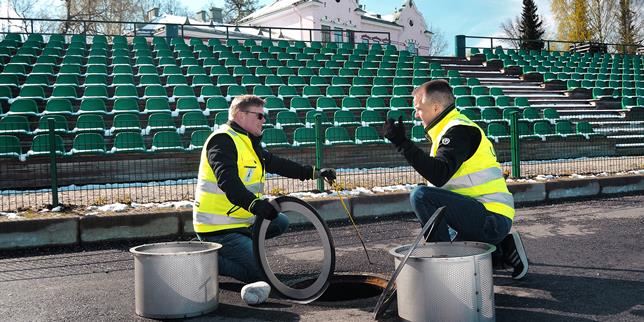The rubber granules from artificial turf fields, familiar to footballers, find their way everywhere – unfortunately also into nature. The drawbacks of these granules have been talked about for years. Granule collectors capture the rubber particles so that they can be recovered, recycled or reused.
“When we first heard about granule collectors, it went without saying that we wanted to invest in them. With the help of granule collectors, it is easy to make sure that nothing that does not belong in nature does not end up there”, says Lahti Aqua’s Managing Director Jouni Lillman.
During the coming summer, granule collectors will be installed in storm water wells at all the artificial turf fields in Lahti. For fields to be renewed, they will be installed in connection with the refurbishment work. The granule collectors are to be paid for by Lahti Aqua and installed and maintained by the City of Lahti.
“In Lahti, environmental issues are taken into account in all of the city’s sectors. The granule collectors are a good example of this. Environmental issues pertain to everyone, everywhere. When we repeatedly make environmentally friendly choices, even small ones have a big combined effect. Lahti is not the European Green Capital 2021 without good reason”, says Milla Bruneau, Executive Director of the Environmental Green Capital project.
The collector to be installed in storm water wells has been developed in cooperation with the Norwegian Football Federation, and these collectors have been installed at numerous sports fields in the Nordic countries.
“In Norway, granules from artificial turf fields must be prevented from entering drains in accordance with the climate and environment administration’s regulation. The country’s approximately 2,000 artificial turf fields will be renewed accordingly at an annual rate of 80 fields. An investigation process into rubber granules was launched as early as in the summer of 2016 at the request of the EU. We are pleased that Lahti Aqua and the City of Lahti were the first in Finland to take responsibility in this matter”, says Kalle Vuorela, Country Manager at Ulefos Oy.
Storm water, i.e. rain and melt water discharged from built-up areas, is a significant source of impurities that end up in surface waters in cities. Heavy metals, nutrients and microplastics, among other things, enter waterways through storm water. Green Capital Lahti was one of the first in Finland to introduce an ambitious storm water programme in 2011.
A number of projects researching and developing methods for managing the quality and quantity of storm water have been implemented in the Green Capital area in cooperation with universities and other partners. The City of Lahti has signed a Baltic Sea Commitment, promising to reduce the nutrient load on the Baltic Sea. Storm water management has a significant impact on this.
